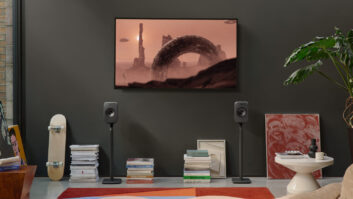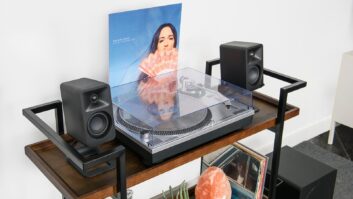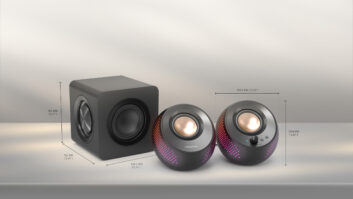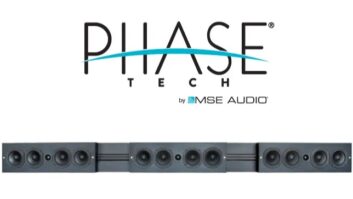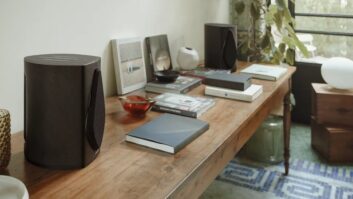LAS VEGAS – Sonos got a lot more competition in the wireless multiroom-audio business during International CES.
House of Marley and Paradigm showed their first wireless multiroom-audio speakers, which incorporate Qualcomm’s AllPlay platform to deliver interoperability among brands. Speaker maker SVS, which didn’t show a product, said it is targeting fourth-quarter availability of its AllPlay-enable speaker. The companies join Monster in launching AllPlay speakers, which support lossless 192kHz/24-bit FLAC, WAV and PCM files as well as MP3, AAC and AAC+.
Also at the show, Samsung, Navvo, and Cabasse expanded their selections, and Braven, LG and Sony launched their first products. Harman Kardon also expanded its selection, and French company Devialet showed two high-end models.
For its part, Supertooth unveiled a wireless multiroom system that uses proprietary RF technology to distribute music from a Bluetooth source around the house.
Also during the show, Qualcomm revealed an expanded list of licensees for its AllPlay wireless-multiroom audio technology and said it expects the companies to launch products in 2015. New licensees with U.S. marketing arms are House of Marley, Inkel/Sherwood, Optoma Nuforce, SVS, TP Link, and TCL Communications, which markets cellphones and tablets under the Alcatel One Touch brand.
For its part, Paradigm showed its first wireless multiroom speakers, which are based on DTS’s Play-Fi technology. DTS is licensing Play-Fi to audio companies to enable different-brand speakers to communicate over a Play-Fi network. Other companies already offering Play-Fi speakers are Polk, Definitive Technology, DTS’s Phorus brand, and Wren Audio. MartinLogan, Anthem, and the Fine Sound Group have also announced plans to offer Play-Fi products. Fine’s brands are McIntosh, Wadia and Sonus Faber.
U.S. shipments of Wi-Fi speakers grew 141 percent in 2014 to 2.48 million units, Futuresource Consulting estimates show. In 2015, shipments will grow another 67.5 percent to 4.15 million, the company forecasts. Some of the Wi-Fi models also include stereo Bluetooth streaming.
By far, sales of Bluetooth-only speakers surpass Wi-Fispeaker sales by a wide margin, accounting for 85 percent of wireless speakers shipped in the U.S. in 2014, Futuresource estimates. But Wi-Fi speakers are coming on strong, accounting for 15 percent of wireless-speaker shipments in 2013, an estimated 19 percent in 2014, and a forecast 23 percent in 2015, including models incorporating both Bluetooth and Wi-Fi.
At the retail level, combined sales of Wi-Fi and Bluetooth speakers rose 63.2 percent in 2014 to $1.78 billion. They will rise a forecast 31 percent in 2015 to $2.32 billion.
The plethora of launches “is good for raising awareness of MRA [multiroom audio], but the diverse and often incompatible technologies involved will begin to reduce down to a few proprietary systems such as Sonos, although the majority will be based upon an open standard, offering Bluetooth as well as Wi-Fi,” said Jack Wetherill, senior market analyst at Futuresource Consulting.
Consumers like the concept, however. A November survey of U.S. consumers by U.K-based Loudhouse found that 30 percent of U.S. consumers wanted to buy products in the next year or two that would control music in multiple rooms from a smartphone or tablet.
Suppliers exhibiting at CES hoped to tap into that demand. Here’s what some of them showed:
Devialet: The Phantom and Silver Phantom from the French company are rounded tabletop speakers with Wi- Fi 802.11a/b/g/n and ability to wirelessly stream 192/24 high-resolution audio. Up to 24 speakers can be used at a time. Phantom is rated at 750 watts peak and delivers 99dB SPLs, The other is rated at 3,000 watts peak and delivers 105dB SPLs. They feature stainless-steel side panels and optical output. European prices are 1,690 euros and 1,990 euros, respectively. U.S. pricing and other details were unavailable.
Harman Kardon: The brand’s $799-suggested Omni Bar soundbar doubles as a wireless multiroom-audio speaker in a Harman Kardon wireless multiroom-audio system that could include $199 and $299 tabletop Wi-Fi speakers and a Wi-Fi receiver, which connects to legacy sound systems. The wireless products are built on Blackfire Research’s platform. The bar is expected to ship in April.
The 2.1-channel soundbar features wireless subwoofer, built-in Wi-Fi and Bluetooth, and One Touch Follow Me Audio – Link button, which lets users walk from one room to another while the music follows them. Audio from a mobile device, networked computer or soundbar-connected TV can be distributed around the house.
Paradigm: The company previewed a Play-Fi system consisting of the PF 800 speaker, estimated to retail at a suggested $799, PF 600 speaker at an estimated $599, and PF Amp with built-in Play-Fi receiver at an estimated $499. The amp/receiver powers a passive pair of stereo speakers. All incorporate proprietary Anthem Room Correction (ARC) technology. They’re targeted to ship in the spring or summer.
The PF 800 speaker is rated at 2×115 watts RMS. Shipments are expected in the spring. The PF 600 speaker is rated at 2×200 watts RMS. And the amp/receiver is rated at 2×100 watts RMS into 4 ohms. Additional details were unavailable.
Supertooth: The Bluetooth accessories maker launched its first multiroom-audio system, expected to ship in the second quarter. The multiroom system uses a Bluetooth device for a source, which transmits music to a base speaker that in turn distributes the music to up to four speakers via proprietary RF wireless technology.
Three- and five-speaker packages will be available at $299 and $480, respectively. They will be available in two color options: black wood/gray grid/black cloth and light oak wood/white grid/gray cloth.
From a Bluetooth device, users can stream devicestored music as well as music apps, including Deezer, Pandora, Spotify, the Internet and YouTube.
Supertooth’s free Multiroom App for Android and iOS devices delivers control over the system. Each speaker can be set to deliver mono, or two speakers can be paired to deliver separate left and right channels. Users can choose a mix of mono and stereo rooms.






